
The Digital Banking Revolution: How Neobanks and Challenger Banks are Redefining Financial Services
With brick-and-mortar banks seemingly frozen in time, a digital rebellion has swept across the financial landscape. Enter neobanks and challenger banks, the fintech cavalry armed with disruptive technology and a laser focus on customer experience. They’re rewriting the rules of the game, leaving traditional banks scrambling to catch up. Today, we delve into the compelling story of this financial shift, exploring the factors driving the rise of these new players, their core strengths, and the challenges they face as they reshape the future of banking.
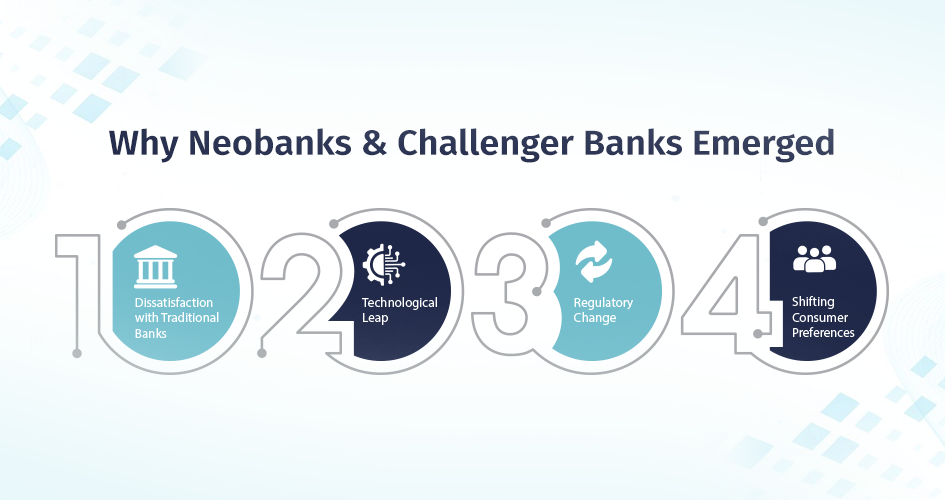
Why Neobanks and Challenger Banks Emerged
Several factors paved the way for the emergence of neobanks and challenger banks:
Dissatisfaction with Traditional Banks: Consumers, frustrated by high fees, impersonal service, and clunky online banking interfaces, yearned for a more convenient and transparent banking experience.
Technological Leap: Advancements in mobile technology, cloud computing, and artificial intelligence provided the tools to build digital banking platforms that were faster, more efficient, and offered greater accessibility.
Regulatory Change: Open banking regulations in some regions gave new entrants access to traditional banks’ data, enabling them to create personalised financial products and services.
Shifting Consumer Preferences: Millennials and Gen Z, comfortable with digital interactions and demanding personalised experiences, became the driving force behind the adoption of these new banking models.
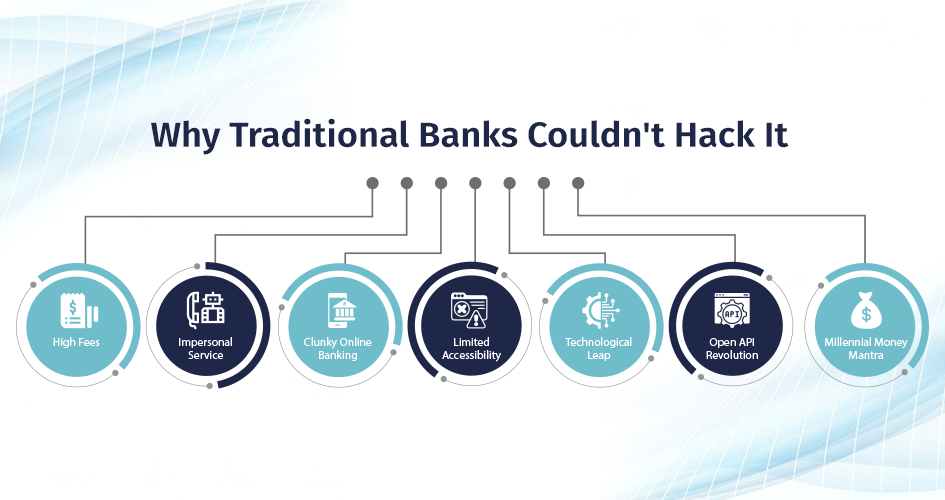
Why Traditional Banks Couldn’t Hack It
Dissatisfaction amongst consumers tired of:
High Fees: Every ATM withdrawal felt like a tollbooth for a highway riddled with hidden charges.
Impersonal Service: Robo-calls replaced friendly tellers, leaving interactions feeling more like automated than financial guidance.
Clunky Online Banking: Lagging interfaces and menus turned simple tasks into digital marathons.
Limited Accessibility: Geographical barriers shut out rural communities, leaving them yearning for a bank in their pocket, not just their town. These frustrations were the fertile ground where neobanks and challenger banks sprouted. Fueled by:
Technological Leap: Cloud computing turned servers into pocket change, mobile apps became the new bank branches, and AI whispered personalised financial advice into customers’ ears.
Open API Revolution: Locked vaults of customer data creaked open, allowing these upstarts to create products tailored to individual needs and spending habits.
Millennial Money Mantra: A generation raised on instant gratification demanded banking that matched their digital lifestyle – seamless, transparent, and available 24/7.
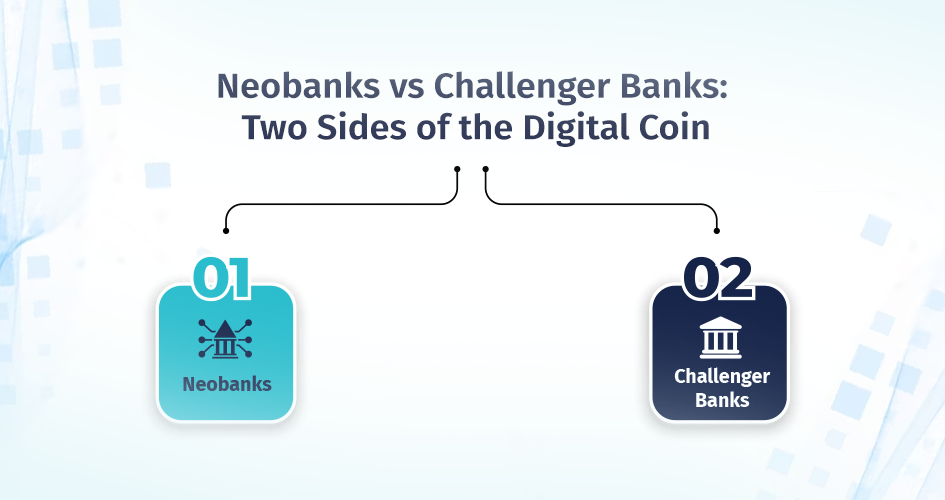
Neobanks vs Challenger Banks: Two Sides of the Digital Coin
While both disrupt the traditional model, they have distinct approaches:
Neobanks: Like digital nomads, they roam the online world, lacking physical branches but offering essential banking services like current accounts, debit cards, and personal loans. Monzo in the UK and Nubank in Brazil are shining examples.
Challenger Banks: They take on the traditional banks head-on, often focusing on specific niches like small businesses or underserved communities. Starling Bank in the UK and SoFi in the US are formidable challengers in this arena.
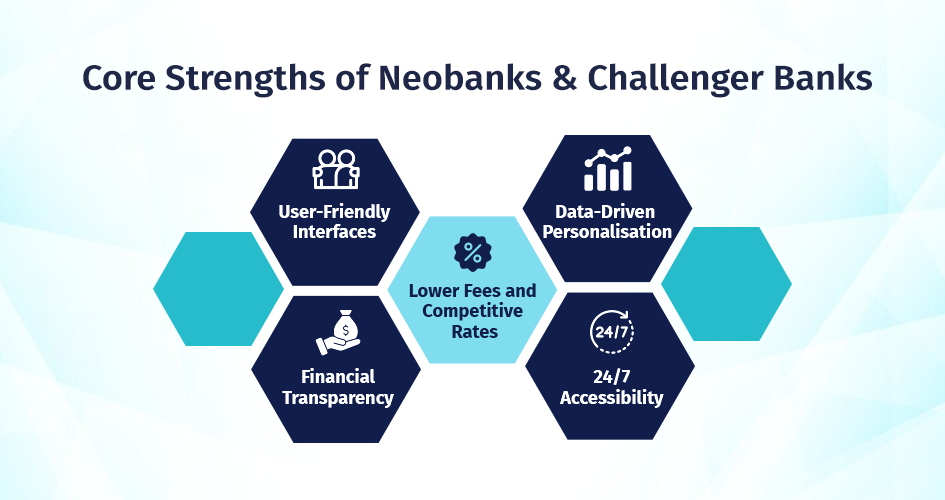
Core Strengths of Neobanks and Challenger Banks
Neobanks and challenger banks offer several advantages:
User-Friendly Interfaces: Mobile apps designed by UX wizards eliminate menu maze-running and replace it with intuitive, tap-and-swipe convenience.
Lower Fees and Competitive Rates: No overhead costs from fancy buildings mean smaller margins and savings passed on to customers.
Data-Driven Personalisation: Algorithms analyse spending habits and suggest budgeting tools, savings goals, and tailored loan options.
Financial Transparency: Real-time transaction notifications and spending insights empower customers to take control of their finances.
24/7 Accessibility: Gone are the days of bank-hour limitations. Digital doors are always open, offering convenience that fits our always-on world.
Challenges and the Road Ahead
Despite their strengths, neobanks and challenger banks face challenges:
Building Trust: Overcoming the inertia of established brands and building trust in a relatively new landscape is a marathon, not a sprint.
Profitability: Building a sustainable business model while offering lower fees and investing in technology can be challenging.
Regulatory Compliance: Navigating complex financial regulations and continuously adapting to evolving policies requires agile strategies.
Cybersecurity Concerns: Relying on online platforms inherently increases the risk of cyberattacks, demanding robust security measures.
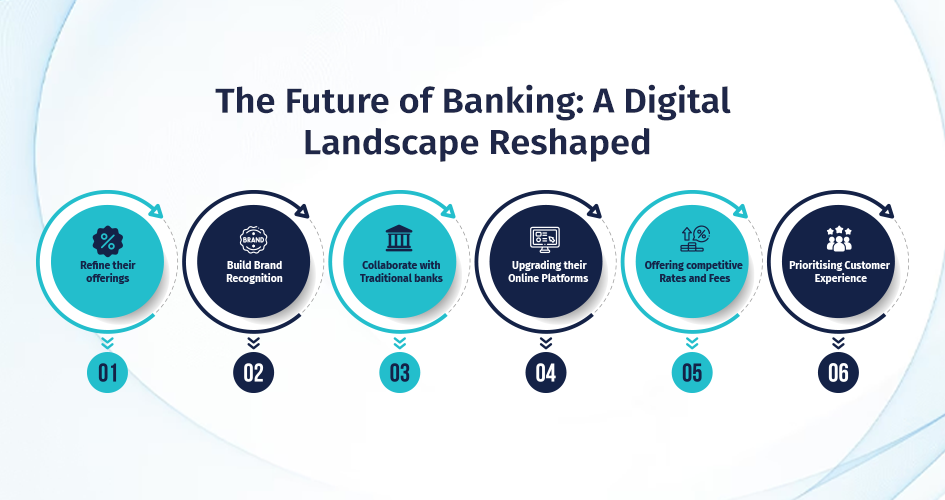
The Future of Banking: A Digital Landscape Reshaped
Despite these challenges, the future of banking seems bright for neobanks and challenger banks. As they:
Refine their offerings: They’re constantly expanding their financial menus from cryptocurrency integration to investment platforms.
Build brand recognition: They’re carving their niches in the digital landscape through strategic partnerships and community engagement.
Collaborate with traditional banks: Partnerships and integrations are creating hybrid models, leveraging the strengths of both worlds.
Upgrading their online platforms: Lagging interfaces are getting polished, embracing sleek designs and user-friendly features.Offering competitive rates and fees: The pressure is on to match the competitive edge of their digital counterparts.
Prioritising customer experience: Personalised services and AI-powered tools are finding their way into traditional bank arsenals.
What are the reasons for individuals to possess a secondary bank account?
Furthermore, consider a hypothetical situation in which all your financial services are consolidated into a single expansive retail bank. The bank undergoes a routine update to its platform but faces unforeseen technological complications. As a result of these problems, you will be unable to access your online bank, use your payment cards, or utilise your banking credentials to verify your identity for a few days. You cannot operate your cards for payment, withdraw cash, or do account-to-account transfers anywhere. What impact would this have on your daily life?
This situation occurred in Finland recently. Individuals who only depended on a single prominent retail bank encountered difficulties as they needed help accessing banking services while resolving maintenance problems. Individuals possessing alternative banking institutions can seamlessly maintain their regular routines. This serves as an excellent illustration of the advantages of retaining a supplementary financial institution.
Given the opportunity to decentralise baking services, it is now imperative to scrutinise your personal finance services and evaluate whether your bank still aligns with your requirements. By transferring a portion of your banking services to a secondary financial institution, you can enhance the level of security and ensure uninterrupted access to your everyday banking services. Secondary banks provide an opportunity to take advantage of more advantageous offers for specific banking services. Ensure that you are accessing the optimal services and benefits provided by the banking industry in a manner that maximises their impact on your life.
Neobanks are a permanent fixture in the banking system, not a passing trend. Contrary to their name, challenger banks can also provide numerous opportunities for creating customised products and services for retail banks. The positive outcomes of the synergy between the two entities are already evident, particularly in India. The advent of neobanks has initiated a comprehensive transformation in the banking industry, as they leverage modern technology and innovative approaches to elevate the consumer experience consistently.
Conclusion
However, the future of banking looks bright for neobanks and challenger banks. They are poised to become significant players in the financial landscape as they refine their offerings, expand their services, and build trust with consumers. They are pushing traditional banks to innovate and become more customer-centric, ultimately leading to a more inclusive and user-friendly banking experience for everyone.
How Can Datavision help?
We assist various financial institutions and global banks on their digital transformation journey. Our one-of-a-kind approach, which combines people, process, and technology, expedites the delivery of superior results to our clients and drives excellence. Several reputed companies leverage our proprietary suite of business excellence tools and services to unlock new growth levers and unparalleled ROI.
Datavision stands proudly as a prominent banking software solutions provider, recognized for our unwavering commitment to excellence in the industry. We have earned our esteemed reputation by consistently delivering cutting-edge core banking software, catering to the needs of both retail and corporate banking software sectors. At Datavision, our mission is clear: to provide our clients with the best banking software products, ensuring that they stay ahead in an ever-evolving financial landscape. We take pride in serving our prestigious clients and look forward to continuing our journey of innovation and excellence.
Our portfolio of banking software product and services include:
Core Banking Solutions: | FinNext Core | Banking: | FinTrade | EasyLoan | MicroFin |
Digital Banking Solutions: | IBanc | MobiBanc | MBranch | FinTab | FinSight |
Risk & Compliance: |FinTrust |
Want to know how our team of experts at Datavision provides customizable, scalable, and cost-effective banking software products and solutions to our esteemed clients? Visit us for more information.